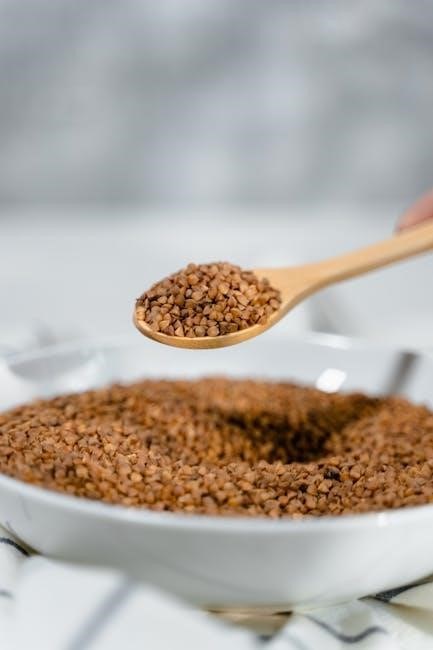The Fasting Mimicking Diet (FMD) is a 5-day‚ plant-based eating program designed to mimic the benefits of fasting while minimizing its challenges.
Developed by Dr. Valter Longo‚ the FMD triggers cellular renewal and autophagy‚ promoting longevity and overall health without complete food deprivation.
It involves strategic caloric restriction‚ focusing on nutrient-dense foods to support the body’s natural repair processes‚ making it accessible for those who find traditional fasting difficult.
This innovative approach has gained popularity for its potential to improve metabolic health‚ reduce biological aging‚ and enhance vitality‚ supported by scientific research and clinical trials.
The FMD is not just a diet but a metabolic intervention aimed at optimizing healthspan‚ offering a sustainable alternative to prolonged fasting for long-term wellness;
What is the Fasting Mimicking Diet?
The Fasting Mimicking Diet (FMD) is a 5-day‚ plant-based dietary program designed to mimic the effects of fasting while allowing for limited food intake. Developed by Dr. Valter Longo‚ the FMD is based on decades of research into the benefits of fasting‚ such as cellular renewal‚ autophagy‚ and improved metabolic health. Unlike traditional fasting‚ the FMD provides essential nutrients through carefully selected‚ low-calorie‚ and nutrient-dense foods. The program restricts calories to 300-1‚100 per day‚ depending on the phase‚ and focuses on minimizing protein‚ carbohydrates‚ and sugar intake while maximizing micronutrient consumption. This approach tricks the body into a fasting-like state‚ promoting longevity and health benefits without the need for complete food deprivation. The FMD has gained popularity for its potential to improve overall wellness and reduce biological aging.
Key Principles of the FMD
The Fasting Mimicking Diet (FMD) is built on specific principles designed to mimic fasting while providing essential nutrients. The diet is a 5-day‚ plant-based program with carefully structured meals to keep calories low (300-1‚100 per day) and nutrient intake high. It emphasizes minimal protein‚ carbohydrates‚ and sugars to induce a fasting-like metabolic state. Hydration and electrolyte balance are prioritized to avoid side effects. The FMD avoids animal products and focuses on whole‚ nutrient-dense foods. This approach triggers autophagy‚ fat-based metabolism‚ and cellular renewal. The diet is scientifically formulated‚ based on research by Dr. Valter Longo‚ to promote longevity and health. It serves as a metabolic reset‚ helping the body transition into a state of self-repair and rejuvenation.
Benefits of the Fasting Mimicking Diet
The Fasting Mimicking Diet (FMD) offers numerous health benefits by mimicking fasting without complete food deprivation. It promotes cellular renewal through autophagy‚ enhancing the body’s natural repair mechanisms. The diet has been shown to improve metabolic health‚ reduce inflammation‚ and support weight management. Additionally‚ it may lower biological aging markers‚ potentially increasing longevity. Enhanced fat burning‚ improved blood sugar control‚ and increased energy levels are also commonly reported. The FMD supports immune system rejuvenation and may reduce cancer risk. Its structured‚ plant-based approach ensures essential nutrient intake while minimizing side effects‚ making it a sustainable option for overall wellness. These benefits make the FMD a popular choice for those seeking a healthier‚ more vibrant lifestyle. Regular practice can lead to long-term improvements in healthspan and vitality.

Understanding the 5-Day Fasting Mimicking Diet Meal Plan
The 5-day Fasting Mimicking Diet is a structured‚ plant-based plan with daily caloric intake around 1‚000 calories‚ emphasizing nutrient-dense foods to mimic fasting benefits without deprivation.
Day 1: Preparing for the FMD
Day 1 of the Fasting Mimicking Diet focuses on mental and physical preparation. Start by committing to the program and understanding its benefits‚ such as cellular renewal and metabolic health;
Clear your pantry of non-compliant foods and shop for approved ingredients‚ including plant-based meals‚ healthy fats‚ and low-calorie snacks. Hydrate thoroughly‚ aiming for at least 8 glasses of water.

Light exercise is encouraged to ease into the diet. Avoid heavy meals and gradually reduce calorie intake to transition smoothly into the fasting-like state. Set intentions for the next 5 days to stay motivated and focused on your health goals;
Day 2: Caloric Restriction and Nutrient Focus
Day 2 of the Fasting Mimicking Diet introduces a significant reduction in caloric intake‚ typically around 500 calories‚ while prioritizing nutrient-dense foods. Meals are carefully designed to provide essential vitamins‚ minerals‚ and antioxidants to support cellular health.
Focus on consuming plant-based foods‚ such as vegetables‚ fruits‚ and whole grains‚ along with healthy fats like olive oil and nuts. Hydration is crucial‚ with an emphasis on water and electrolyte-rich beverages to prevent fatigue and dizziness.
This phase aims to transition your body into a fasting-like state‚ promoting autophagy and metabolic reset. Avoid high-protein or high-carbohydrate foods‚ as they can counteract the fasting effects. Stick to the meal plan to ensure optimal nutrient balance and minimize side effects.

Day 3: Optimizing Macronutrient Balance
On Day 3 of the Fasting Mimicking Diet‚ the focus shifts to optimizing macronutrient balance while maintaining caloric restriction. Meals are tailored to provide a balanced mix of protein‚ carbohydrates‚ and fats‚ ensuring your body remains in a fasting-like state.
Protein intake is kept low to avoid activating growth factors‚ while complex carbs and healthy fats are emphasized to sustain energy levels. Plant-based foods like vegetables‚ legumes‚ and nuts are central to the menu‚ along with small portions of whole grains.
Hydration and electrolyte balance are critical to prevent fatigue and support overall well-being. Herbal teas and vegetable broths can complement water intake to replenish lost salts.
This phase ensures your body continues to benefit from autophagy and metabolic renewal‚ setting the stage for the next stages of the diet.
Day 4: Enhancing Autophagy and Renewal
By Day 4 of the Fasting Mimicking Diet‚ your body is in a heightened state of autophagy‚ a natural process where cells recycle damaged components. Meals are carefully calibrated to maintain caloric restriction while optimizing nutrient intake‚ typically around 450 calories for the day.
Protein intake remains low to avoid triggering growth signals‚ while complex carbohydrates and healthy fats are emphasized for energy. Plant-based foods like leafy greens‚ cruciferous vegetables‚ and small portions of whole grains are central to the menu.
Hydration is critical‚ with a focus on water and electrolyte-rich beverages to prevent fatigue. Herbal teas and vegetable broths are recommended to support electrolyte balance and overall well-being.
This phase reinforces the body’s natural renewal processes‚ preparing it for the transition back to normal eating in the final day of the program.
Day 5: Transitioning Back to Normal Eating
Day 5 marks the final phase of the Fasting Mimicking Diet‚ focusing on a gradual transition back to regular eating. Caloric intake increases slightly‚ typically around 700-800 calories‚ to ease the body out of fasting mode.
Meals reintroduce more variety and texture‚ with a balance of protein‚ healthy fats‚ and complex carbohydrates. Breakfast might include small portions of whole grains or vegetables‚ while lunch and dinner focus on nutrient-dense‚ plant-based dishes to maintain metabolic balance.
Hydration remains essential‚ and electrolytes are replenished to support the body’s recovery. This phase ensures a smooth transition‚ minimizing potential digestive discomfort and preparing the body for normal eating habits post-FMD.
The goal is to maintain the metabolic benefits while gradually restoring energy levels and normal digestive function‚ setting the stage for a healthier relationship with food.

Nutritional Guidelines for the Fasting Mimicking Diet
The FMD is a plant-based‚ low-calorie‚ low-protein‚ and low-carbohydrate diet designed to mimic fasting benefits while providing essential micronutrients. Daily caloric intake ranges from 300 to 500 calories on Day 1‚ increasing slightly on subsequent days to support metabolic needs and promote autophagy‚ ensuring a balance of macronutrients and micronutrients for optimal health outcomes.
Caloric Intake and Restrictions
The Fasting Mimicking Diet (FMD) involves significant caloric restriction‚ typically limiting daily intake to 300-500 calories‚ with a gradual increase on subsequent days. The first day usually allows 300-400 calories‚ while Days 2-4 may range from 400-500 calories‚ ensuring minimal nutrient deprivation. The diet emphasizes plant-based‚ nutrient-dense foods to support metabolic health and promote autophagy. Protein and carbohydrate intake is kept low‚ focusing on whole grains‚ vegetables‚ and healthy fats. Hydration is crucial‚ with recommendations to drink plenty of water and monitor electrolyte levels to avoid deficiencies. This structured caloric approach mimics fasting’s benefits while providing essential nutrients‚ supported by research from Dr. Valter Longo and others. Consulting a healthcare provider is advised to ensure safety and suitability for individual needs.
Macronutrient Breakdown: Protein‚ Carbs‚ and Fats

The Fasting Mimicking Diet (FMD) emphasizes a specific balance of macronutrients to mimic fasting effects while providing essential nutrients. Protein intake is kept low‚ typically around 9-12 grams per day‚ to minimize insulin spikes and promote autophagy. Carbohydrates are also restricted‚ focusing on low-glycemic sources like vegetables and whole grains‚ to maintain fasting-like metabolic states. Healthy fats‚ such as those from olives‚ avocados‚ and nuts‚ are prioritized to provide energy and satiety. The diet is predominantly plant-based‚ with minimal animal products‚ ensuring a nutrient-dense yet calorie-restricted intake. This strategic macronutrient breakdown supports cellular renewal and metabolic health‚ aligning with the FMD’s goal of replicating the benefits of prolonged fasting in a shorter‚ more manageable period.
Hydration and Electrolyte Balance
Hydration and electrolyte balance are crucial during the Fasting Mimicking Diet (FMD) to support bodily functions and prevent potential side effects. Drinking plenty of water and herbal teas is encouraged to stay hydrated‚ while electrolytes like sodium‚ potassium‚ and magnesium must be carefully managed. The FMD meal plan often includes small amounts of these minerals through specific foods or supplements to avoid deficiencies. Proper hydration helps maintain energy levels and supports the body’s natural detox processes. Monitoring electrolyte levels is essential to prevent fatigue‚ dizziness‚ or other symptoms. The diet’s guidelines emphasize the importance of balancing fluids and electrolytes to ensure a safe and effective fasting-mimicking experience‚ particularly during the 5-day program. This attention to hydration and electrolytes helps maximize the diet’s benefits while minimizing discomfort.
Supplements and Essential Nutrients
During the Fasting Mimicking Diet‚ certain supplements and essential nutrients play a vital role in supporting overall health and maximizing the diet’s benefits. Multivitamins are often recommended to ensure adequate micronutrient intake‚ while omega-3 fatty acids and probiotics may support heart health and gut function. Additionally‚ vitamin D‚ magnesium‚ and zinc are frequently emphasized to maintain immune function and energy levels. These supplements help bridge potential nutritional gaps due to the diet’s caloric and protein restrictions. However‚ it’s crucial to consult a healthcare provider before adding any supplements to avoid over-supplementation or interactions with medications. The FMD’s focus on plant-based‚ nutrient-dense foods also naturally provides essential vitamins and minerals‚ further enhancing the diet’s therapeutic effects.

Sample Recipes for the Fasting Mimicking Diet
Discover nutrient-dense‚ plant-based recipes designed for the FMD‚ including soups‚ salads‚ and balanced meals‚ all strategically formulated to support fasting-like benefits while nourishing your body.
Breakfast Options: Low-Calorie‚ Nutrient-Dense Meals
Start your day with nutrient-rich‚ plant-based breakfasts designed to support the FMD. Recipes include chia pudding with flaxseeds and berries‚ providing omega-3s and fiber‚ or a spinach and kale smoothie packed with vitamins and minerals. These meals are low in calories but high in nourishment‚ ensuring you stay within the FMD’s guidelines while energizing your body. Incorporate ingredients like hemp seeds‚ almond butter‚ and avocado for healthy fats and protein. Avoid animal products and focus on whole‚ unprocessed foods to align with the FMD’s plant-based approach. These breakfast options not only satisfy but also promote metabolic health and cellular renewal‚ making them a great start to your fasting mimicking journey.
Lunch Ideas: Soups‚ Salads‚ and Plant-Based Proteins
For lunch‚ focus on soups‚ salads‚ and plant-based proteins that are nutrient-dense and low in calories. Lentil or vegetable soups are excellent options‚ as they provide fiber and essential vitamins. Salads can feature mixed greens‚ cucumbers‚ bell peppers‚ and avocado‚ dressed with olive oil and lemon juice. Plant-based proteins like tofu‚ tempeh‚ or edamame can be added for satiety. Quinoa or chickpea salads are also great‚ offering a balance of protein and carbs. These meals align with the FMD’s principles of caloric restriction while delivering vital nutrients. Herbs and spices enhance flavor without adding calories‚ ensuring meals are satisfying and supportive of the fasting mimicking process.
Dinner Recipes: Balanced and Satisfying Meals
Dinner on the FMD should be balanced‚ satisfying‚ and nutrient-rich while maintaining caloric restrictions. Vegetable stir-fries with tofu or tempeh‚ roasted vegetable medleys‚ and stuffed bell peppers are popular choices. Quinoa or brown rice bowls with steamed vegetables and a drizzle of olive oil are also ideal. Incorporate leafy greens‚ cruciferous vegetables‚ and herbs for flavor. Plant-based proteins like lentils or chickpeas can be added for variety. Soups‚ such as minestrone or butternut squash‚ are comforting and filling. Ensure meals are seasoned with spices and low-calorie dressings like lemon juice or balsamic vinegar. These recipes provide sustained energy and support the body’s natural renewal process during the FMD‚ keeping you full and nourished while adhering to the program’s guidelines.
Snacks: Healthy‚ Low-Calorie Choices
Snacks on the FMD should be nutrient-dense‚ low in calories‚ and align with the program’s principles. Opt for raw or roasted vegetables like cucumbers‚ bell peppers‚ or zucchini. A small handful of nuts or seeds‚ such as almonds or pumpkin seeds‚ can provide healthy fats and protein. Fresh fruit‚ like berries or citrus‚ offers natural sweetness and fiber. Consider veggie sticks with a light hummus or guacamole dip for added creaminess. Herbal teas or infused water can also serve as hydrating‚ calorie-free options. These snacks help maintain energy levels while supporting the body’s fasting-like state‚ ensuring adherence to the FMD without compromising its benefits.

Safety and Precautions
Consult a healthcare provider before starting the FMD‚ especially if you have medical conditions. Avoid if pregnant‚ breastfeeding‚ or with certain chronic illnesses. Monitor for side effects like fatigue or dizziness and adjust as needed to ensure safety and effectiveness throughout the program.
Who Should Avoid the Fasting Mimicking Diet?
Certain individuals should avoid the Fasting Mimicking Diet (FMD) due to potential health risks. These include pregnant or breastfeeding women‚ as the diet may deprive the fetus or baby of essential nutrients. People with chronic illnesses‚ such as diabetes‚ heart disease‚ or advanced liver or kidney disease‚ should also avoid FMD without medical supervision. Additionally‚ those with a history of eating disorders or severe malnutrition should not attempt the diet. Individuals taking certain medications or with a very low BMI may also be at risk. It is crucial to consult a healthcare provider before starting the FMD‚ especially for those with underlying health conditions or concerns.
Possible Side Effects and How to Manage Them
Common side effects of the Fasting Mimicking Diet (FMD) include fatigue‚ dizziness‚ and hunger‚ particularly during the initial days. These symptoms often subside as the body adapts. To manage fatigue‚ ensure adequate rest and avoid strenuous activities. Staying hydrated and maintaining electrolyte balance can help reduce dizziness. Hunger pangs can be alleviated by adhering to the structured meal plan and eating nutrient-dense foods. Some individuals may experience mild nausea or headaches‚ which can be mitigated by gradually transitioning into the diet and avoiding sudden calorie restriction. If side effects persist or worsen‚ it is advisable to pause the diet and consult a healthcare provider for guidance. Proper preparation and adherence to the meal plan can minimize discomfort and enhance the overall experience. Monitoring progress and adjusting as needed is key to a successful FMD journey.
Monitoring Progress and Adjustments
Monitoring progress during the Fasting Mimicking Diet (FMD) involves tracking metrics such as weight‚ energy levels‚ and overall well-being. Regularly assessing how your body responds to the diet is crucial for maximizing benefits and ensuring safety. Key metrics to track include caloric intake‚ macronutrient balance‚ and hydration levels. Some individuals may experience faster adaptation‚ while others may need adjustments to avoid discomfort. Adjustments might include modifying portion sizes‚ incorporating electrolyte-rich foods‚ or extending the transition period. It’s important to listen to your body and make tweaks to maintain consistency while adhering to the program’s guidelines. Tracking biomarkers like blood sugar levels and ketosis can also provide insights into metabolic changes. Consulting a healthcare provider for personalized advice ensures a safe and effective experience. Consistent monitoring allows for timely adjustments‚ enhancing the diet’s overall effectiveness and sustainability.
Consulting a Healthcare Provider
Consulting a healthcare provider before starting the Fasting Mimicking Diet (FMD) is essential‚ especially for individuals with pre-existing medical conditions. A healthcare professional can assess your health status and determine if the FMD is suitable for you. They will consider your medical history‚ medications‚ and any underlying health issues that may require special attention. Discussing your plans with a doctor ensures safe implementation and helps prevent potential complications. Regular check-ups during and after the diet can monitor biomarkers‚ such as blood sugar and ketone levels‚ to assess metabolic changes. A healthcare provider can also offer personalized guidance‚ addressing concerns and optimizing the diet’s benefits. This collaboration ensures a safe and effective experience‚ tailored to your unique needs and health goals.

The Fasting Mimicking Diet offers a structured‚ 5-day plant-based approach to mimic fasting benefits‚ promoting cellular renewal and metabolic health. For sustained results‚ incorporate FMD cycles periodically‚ as recommended by experts like Dr. Valter Longo. Post-diet‚ maintain a balanced lifestyle and consult a healthcare provider for personalized guidance.
Long-Term Benefits of Incorporating FMD
Incorporating the Fasting Mimicking Diet into your lifestyle can lead to significant long-term health benefits‚ including enhanced cellular renewal and improved metabolic function.
Studies suggest that periodic FMD cycles may promote longevity by reducing biological aging and enhancing autophagy‚ the body’s natural cleansing process.
Regular use of FMD has been linked to improved insulin sensitivity‚ better weight management‚ and reduced inflammation‚ all of which contribute to overall wellness.
Additionally‚ FMD may support immune system rejuvenation and increase human lifespan by protecting against age-related diseases‚ making it a valuable addition to a healthy lifestyle.
By mimicking fasting without extreme calorie deprivation‚ FMD offers a sustainable way to achieve lasting health benefits while maintaining nutritional balance.
Many users report feeling more energetic and mentally clarity after completing multiple FMD cycles‚ further highlighting its potential for long-term well-being.
How to Maintain a Healthy Lifestyle Post-FMD
After completing the Fasting Mimicking Diet‚ maintaining a healthy lifestyle is crucial to sustain its benefits and promote long-term wellness.
Focus on incorporating whole‚ nutrient-dense foods‚ including fruits‚ vegetables‚ lean proteins‚ and healthy fats‚ into your daily meals to support overall health.
Stay hydrated by drinking plenty of water and consider intermittent fasting or mindful eating practices to maintain calorie balance and metabolic health.
Regular physical activity‚ such as walking or strength training‚ can enhance the effects of FMD by improving insulin sensitivity and energy levels.

Aim for 7-8 hours of quality sleep nightly to support cellular repair and hormonal balance‚ which are essential for maintaining the benefits of FMD.
Consider incorporating the FMD periodically‚ such as every 1-3 months‚ to continue promoting cellular renewal and metabolic optimization.
Monitor your progress‚ track biomarkers‚ and consult a healthcare provider to ensure your lifestyle choices align with your health goals.
Resources for Further Learning
For those interested in exploring the Fasting Mimicking Diet further‚ several resources are available to deepen understanding and implementation.
The official ProLon website offers detailed guides‚ meal plans‚ and scientific backing for the FMD‚ providing a comprehensive starting point.
Dr. Valter Longo’s book‚ The Longevity Diet‚ explores the science behind fasting-mimicking diets and their role in promoting health and longevity.
Peer-reviewed journals like Nature Communications and Aging Research Reviews publish studies on FMD’s effects‚ offering evidence-based insights.
Online communities‚ such as fasting-focused forums and social media groups‚ share DIY meal plans and personal experiences with FMD.
Nutrition blogs and websites provide FMD-compatible recipes and tips for maintaining a healthy lifestyle post-diet.
Consulting healthcare providers or registered dietitians can also offer personalized guidance and support for incorporating FMD into your routine.
